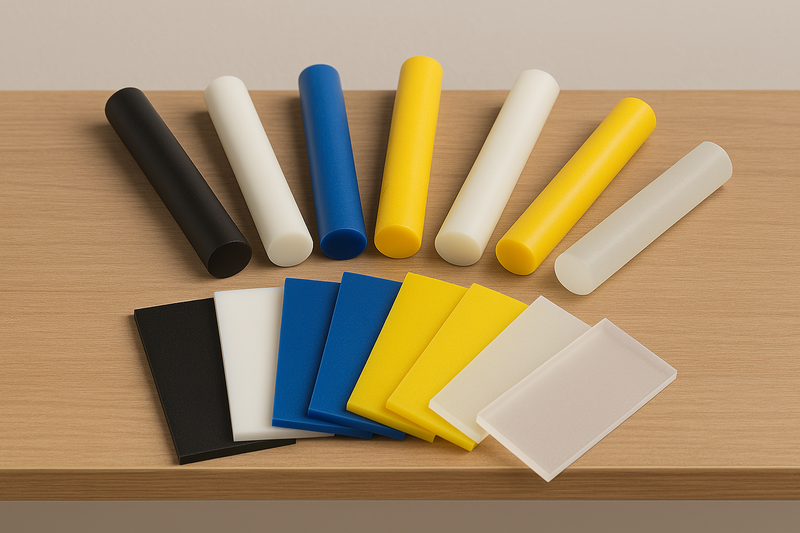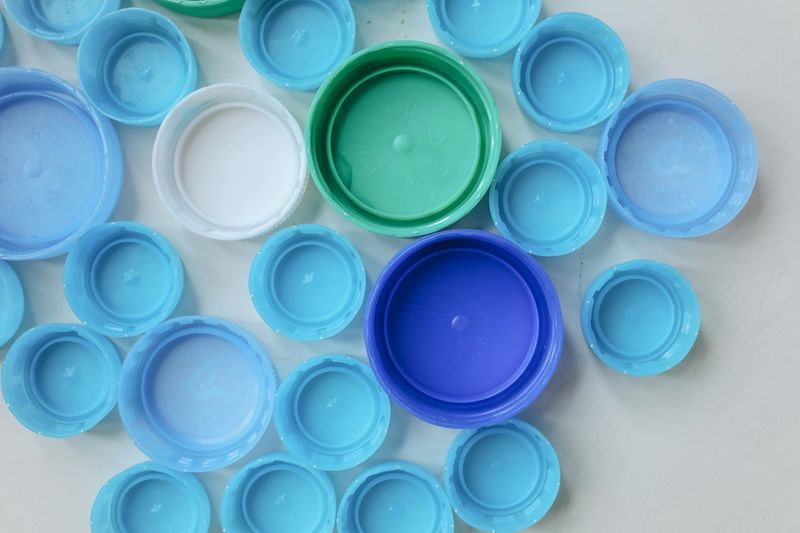At a glance
- Engineering plastics are durable, heat- and chemical-resistant polymers used across industries.
- Identify them by texture, colour, transparency, and hardness.
- Choose the right type for optimal performance and durability.
Engineering plastics' introduction to the plastic industry has been very significant. This product has it all, from remarkable mechanical qualities & adaptability to a variety of uses, making them essential to current industries. This material can be found in almost every business, including consumer goods, industrial business, agriculture, medical equipment, technological devices, and automobile parts.
Saying that it is essential for you to identify the different types of engineering plastics and figure out which one suits you the best based on your needs.
So, in this blog, we will discuss how you can choose and determine the right engineering plastics for your application. But first, let us know what engineering plastic is.
What is Engineering Plastic?
Engineering plastics is a combination of synthetic polymers produced for high-performance applications, i.e. high mechanical strength, toughness, and environmental resistance to heat, chemicals & abrasion. They are used in high-performance material markets requiring precision, durability, and safety.
Some of the common areas where engineering plastics are used include:
- Manufacturing Industry
- Agriculture
- Aerospace
- Electronics
- Consumer goods
How to Identify Engineering Plastics?
You need not be an engineer to identify the engineering plastic and know what is best for you. You can learn about some of the unique characteristics & appearances, and thats it, you will find it easy to identify them. Let us speak about the most common types of engineering plastics and how you can identify them.
Acetal
ACETAL is a strong and durable engineering thermoplastic that is frequently used in the manufacturing of precision parts. It provides low friction, good dimensional stability, and great rigidity.
Features
- Smooth, hard, and slightly waxy surface
- Dense and rigid with a solid, heavy feel
- Typically white (natural), but also available in black and other colours
- Opaque with a glossy finish
How to Identify Them
Acetal, or POM (Polyoxymethylene), is a white, slick surface hard plastic. It's best suited to accuracy precision pieces where dimensionally accuracy is required such as gears, bearings, and electrical connectors. If what you need is a product with significant resistance to wear and chemical exposure, then use Acetal.
Cast Nylon
Cast Nylon is an engineered polymer that has toughness, wear resistance, tensile strength and lubricity. This engineering plastic has substituted metals and alloys such as steel, aluminium, brass, bronze, and others in many industrial applications.
Features
- Waxy, smooth surface with a slight gloss
- Hard, tough, and slightly flexible under pressure
- Natural colour is milky-white, but often dyed black, blue, or green
- Opaque with a matte to semi-gloss finish
How to Identify Them
Cast Nylon is usually found in natural (milky white) or black finishes which is characterised by a shiny, smooth surface and is used where there is a requirement for high strength and durability. Cast Nylon is utilised most frequently in wear items, bushings, and gears.
High-Density Polyethylene (HDPE)
HDPE is a strong, extremely tensile plastic that belongs to the group of semi-crystalline polyethylenes. Because of its linear structure and low branching, it has the ideal strength-to-density ratio. HDPE's tolerance to high temperatures makes it a popular material for a variety of industries.
Features
- Matte, smooth surface with a slightly waxy texture
- Lightweight and flexible, but tough
- Semi-translucent (natural white) or opaque in black, blue, or green
- Soft, scratch-resistant surface
How to Identify Them
HDPE is a rugged, lightweight plastic widely found in products such as containers, pipes, and for outdoor purposes. It tends to be either translucent or opaque with a smooth texture. HDPE can perform in extreme conditions and is perfect for industrial use, such as in tanks and pipes, because it is a chemical-resistant material.
Polyether Ether Ketone (PEEK)
Polyether Ether Ketone (PEEK) is a cutting-edge semi-crystalline substance that is renowned for its remarkable blend of superior chemical resistance, high mechanical qualities, and temperature resistance.
Features
- Hard, rigid, and dense with a smooth surface
- Slightly textured, giving it a technical, industrial feel
- Natural colour: Light brown, tan, or beige
- Opaque and non-reflective
How to Identify Them
PEEK is a high-performance plastic that is typically light beige. It's used in extreme environments where chemical resistance and high temperatures are required, so it's popular in aerospace, automotive, and medical applications. If you're working on components that need to endure harsh environments, PEEK is a safe choice.
Polyethylene Terephthalate (PET)
Polyethylene terephthalate (PET) is a translucent, strong, and lightweight material that belongs to the polyester group. PET is the most widely used thermoplastic polymer resin in the polyester category. They are used in textile fibres, food and liquid containers, thermoforming, and engineering resins when combined with glass fibre.
Features
- Smooth, hard surface with a glossy finish
- Dense and rigid with high impact resistance
- Natural colour: Transparent or clear, can also be opaque in white or blue
- Very glass-like in clear forms
How to Identify Them
PET is typically lightweight and clear in nature. PET is extremely common in packaging, especially in food and drink packaging. It looks even clearer and more impact-resistant and is generally used in visual applications such as displays and medical devices. PET's strength and lightweight nature find it useful in numerous industries.
Polycarbonate (PC)
Polycarbonates is a class of thermoplastic polymers which has carbonate groups in their molecular structures. Polycarbonates, as engineering plastics, are becoming more common because they are durable, made from strong materials, and are generally transparent.
Features
- Smooth and glass-like with a glossy surface
- Tough and impact-resistant but slightly flexible
- Usually transparent or translucent, but can be coloured
- Feels cool and hard, with a rigid structure
How to Identify Them
Polycarbonate is transparent and is often used where clarity and high-impact strength are required. It's found in eyeglasses, lenses, automobile parts, and lamps. If you need a material that provides clarity without sacrificing toughness, then polycarbonate is the choice suggested by many.
Polytetrafluoroethylene (PTFE)
PTFE, sometimes referred to as Teflon or Polytetrafluoroethylene, is a high-performance plastic that is well-known for its remarkable chemical, electrical, and heat qualities, as well as its remarkable slip characteristics. PTFE is a popular option for usage in high-temperature settings because it maintains its stability at temperatures as high as 260 degrees Celsius (500 degrees Fahrenheit).
Features
- Soft, waxy, and slippery to the touch
- Feels slightly rubbery and flexible but tough
- Natural colour: Bright white, opaque, and matte
- Non-stick and doesn’t attract dirt or oil
How to Identify Them
PTFE, or more commonly known as Teflon, is a white, waxy plastic. It is arguably most well-known for non-stick coatings and chemical resistance. PTFE is used widely in seals, gaskets, bearings, and food uses such as cookware. It is of the greatest significance to high-performance applications owing to its high temperature and chemical resistance.
Ultra-High Molecular Weight Low-Pressure Polyethylene (UHMWPE)
Ultra-high molecular weight Low-Pressure Polyethylene is a multipurpose plastic with remarkable qualities. Its great impact strength, superb sliding qualities, and exceptional resistance to chemicals, water absorption, and abrasion are all evident. However, it is not recommended for high-temperature applications.
Features
- Very smooth and slightly waxy texture
- Lightweight but extremely tough and durable
- Natural colour: Milky white, but often available in black, green, or blue
- Opaque with a satin or matte finish
How to Identify Them
UHMWPE is a tough and durable material with a normal white or off-white colour. It has superior wear and abrasion resistance and is often used in applications like conveyor systems, cutting boards, and medical devices. UHMWPE's abrasive wear resistance makes it ideal for parts that suffer high friction.
In conclusion, engineering plastics have transformed industries with their improved mechanical properties, toughness, and flexibility. Being able to identify different types of engineering plastics will help you choose the right material for specific uses. Through an examination of typical features such as texture, colour, transparency, and strength, you can easily differentiate among some of the common engineering plastics, including Acetal, Cast Nylon, HDPE, PEEK, PET, Polycarbonate, PTFE, and UHMWPE.
Looking for high-quality engineering plastics for your next project? Visit National Engineering Plastics to explore our extensive range of premium products, or contact our experts for personalised recommendations!







